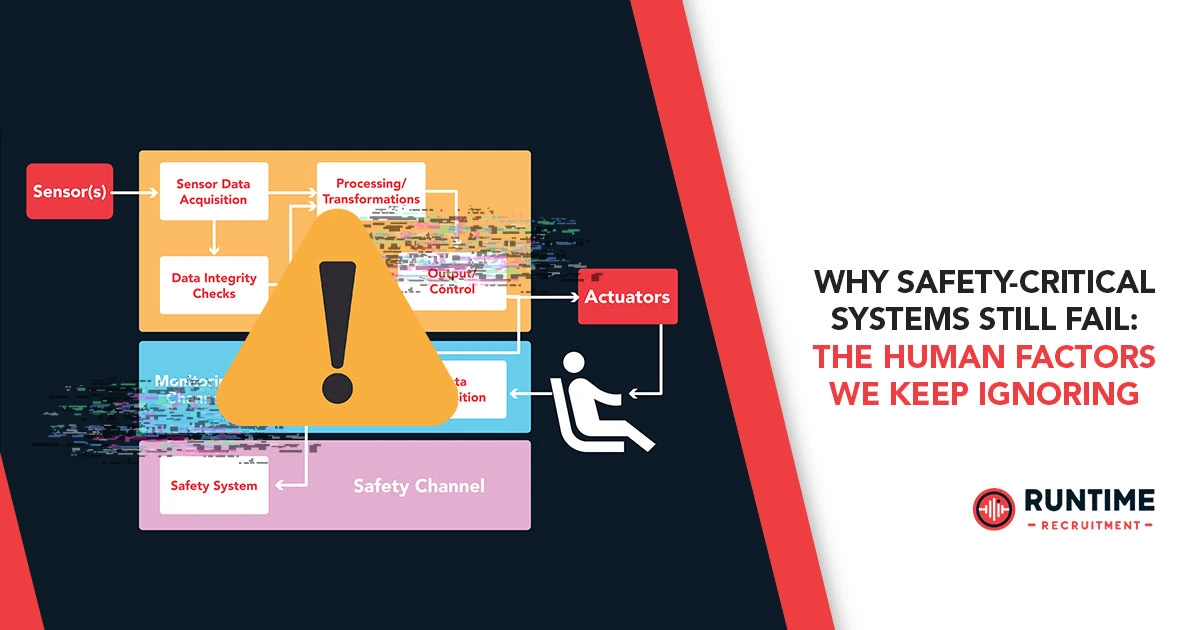The phrase “safety-critical system” conjures images of meticulous design, rigorous testing, exhaustive verification, and ironclad code. We pore over standards like ISO 26262, IEC 61508, and DO-178C, implement redundant hardware, employ formal methods, and strive for fault tolerance at every layer. Yet, despite these formidable efforts, safety-critical systems continue to fail, sometimes with catastrophic consequences. The uncomfortable truth, often overlooked in our pursuit of technical perfection, is that a significant proportion of these failures aren’t purely technical. They are, at their heart, human failures – the result of human factors we persistently underestimate, mismanage, or outright ignore.
This article delves into the insidious ways human factors contribute to failures in safety-critical embedded systems, challenging embedded engineers to look beyond the circuit board and the codebase to the very people who conceive, design, build, test, deploy, and maintain these vital systems.
The Illusion of Automation and the Persistent Human Element
One of the most pervasive myths in safety-critical engineering is that increasing automation inherently reduces human error. While automation can indeed remove humans from repetitive or dangerous tasks, it often shifts the nature of human involvement rather than eliminating it. Operators become monitors, maintainers, and responders to unforeseen circumstances. This shift introduces new classes of human error:
- Complacency and Skill Degradation: When systems are highly automated, human operators can become complacent. Their attention may wane, and their manual skills for intervention can degrade over time. In an emergency, their ability to react quickly and correctly is compromised. This “operator drop-out” is a well-documented phenomenon.
- Automation Bias: Humans tend to over-rely on automated systems, even when their own observations suggest otherwise. This automation bias can lead to a failure to question or override incorrect automated decisions, with potentially dire results.
- “Black Box” Syndrome: As systems become more complex and automated, their internal workings can become opaque. Engineers and operators may not fully understand why a system behaved in a particular way, making diagnosis and recovery from anomalous states exceedingly difficult. This lack of transparency can hinder effective human intervention.
We must recognize that even the most automated systems are still profoundly human-centric. The decisions made during their design dictate their behavior, and human interaction remains critical for successful operation and intervention.
The Cognitive Pitfalls of Design and Development
The journey from concept to deployment for any embedded system is fraught with decision points, and at each, human cognitive biases and limitations can introduce vulnerabilities that fester into full-blown failures.
- Confirmation Bias: Engineers, like all humans, tend to seek out and interpret information in a way that confirms their existing beliefs or hypotheses. This can lead to overlooking critical flaws in a design or misinterpreting test results that contradict a preconceived notion of correctness.
- Anchoring Bias: Early information or initial design choices can disproportionately influence subsequent decisions. This “anchoring” can prevent engineers from objectively evaluating alternative, potentially safer, approaches later in the development cycle.
- Overconfidence Bias: The inherent complexity of embedded systems, especially those deemed safety-critical, often leads to an overestimation of one’s ability to predict all possible failure modes or to deliver a perfect solution. This overconfidence can lead to insufficient testing, lax review processes, and a reluctance to seek external validation.
- Hindsight Bias: After an incident, there’s a natural tendency to believe that the outcome was predictable or obvious all along. This hindsight bias can impede effective root cause analysis, leading to a focus on proximate causes (e.g., “operator error”) rather than the deeper systemic human factors that contributed to the failure.
- “Not Invented Here” Syndrome: A reluctance to adopt external solutions, best practices, or even warnings due to a preference for internally developed approaches can lead to the re-introduction of known vulnerabilities or inefficient practices.
- Complexity Creep: The natural tendency to add features and capabilities can lead to excessively intricate designs. Overly complex systems are inherently harder for humans to comprehend, test, and maintain, increasing the likelihood of errors during all phases of the lifecycle. This is often an organizational and psychological pressure, not purely a technical one.
Mitigating these biases requires deliberate strategies: promoting diverse perspectives in design reviews, encouraging critical self-reflection, fostering a culture of questioning assumptions, and utilizing structured decision-making frameworks that challenge initial impressions.
Organizational and Cultural Dysfunctions: The Breeding Ground for Failure
Beyond individual cognitive biases, the organizational environment and prevailing safety culture play an enormous role in shaping human performance and, consequently, system safety.
- Weak Safety Culture: A strong safety culture, characterized by a shared commitment to safety, open communication about hazards, and a willingness to learn from mistakes, is paramount. Conversely, a weak safety culture—one that prioritizes schedule or cost over safety, punishes error instead of analyzing its causes, or tolerates shortcuts—is a breeding ground for failure. Leadership commitment to safety, visible through resource allocation and active participation, is crucial for fostering a robust safety culture.
- Communication Breakdowns: Safety-critical projects involve multidisciplinary teams: hardware engineers, software engineers, systems engineers, test engineers, project managers, and often regulatory bodies. Poor communication channels, ambiguous terminology, hierarchical communication barriers, or a lack of documentation can lead to misunderstandings, missed requirements, and overlooked integration issues. Shift handovers, for instance, are notorious points for communication failures.
- Time and Resource Pressure: Unrealistic deadlines and insufficient resources exert immense pressure on engineers, leading to rushed decisions, overlooked details, reduced testing, and a higher propensity for errors. The pressure to “get it done” can override safety considerations. This isn’t just about monetary resources; it’s also about adequate staffing and the provision of necessary tools and training.
- Inadequate Training and Competency Management: Even the most brilliant engineers can make mistakes if they are not adequately trained on the specific tools, processes, and nuances of a safety-critical domain. Furthermore, competency isn’t a static state; it requires continuous development and regular assessment, especially as technologies evolve. A failure to invest in ongoing training or to effectively manage skill gaps within the team directly translates to increased risk.
- Lack of Psychological Safety: If engineers fear reprisal for reporting errors, near misses, or even concerns about potential issues, these critical insights will remain hidden. A lack of psychological safety stifles open communication and prevents valuable lessons from being learned, allowing systemic problems to persist.
- Siloed Teams and Information: When teams operate in isolation, knowledge sharing diminishes, and a holistic understanding of the system’s interdependencies can be lost. This “silo effect” can lead to localized optimizations that negatively impact overall system safety, as well as critical information not reaching the right people at the right time.
Addressing these organizational factors requires a top-down commitment to safety, fostering transparent communication, investing in training and development, and creating an environment where learning from mistakes is celebrated, not punished.
The Human-System Interface: Where Design Meets Reality
The interface between the human operator and the embedded system is a critical juncture where human error can be exacerbated or mitigated. Poorly designed human-system interfaces (HSIs) are a significant contributor to failures.
- Confusing or Ambiguous Displays: Information overload, inconsistent symbology, or poorly designed visual hierarchies can make it difficult for operators to quickly and accurately assess system status, especially under stress. This can lead to misinterpretation of data and incorrect decisions.
- Lack of Feedback and Responsiveness: Operators need clear, timely, and unambiguous feedback on their actions and the system’s response. A lack of feedback can leave them unsure if a command was executed or if the system is behaving as expected, leading to repeated attempts or incorrect adjustments.
- Poorly Designed Controls: Controls that are not intuitively mapped to their functions, require excessive dexterity, or are easily confused with other controls can lead to slips and lapses. Physical layout, tactile feedback, and logical grouping are crucial.
- Alarm Fatigue: Systems that generate an excessive number of alarms, many of which are non-critical or false, can desensitize operators, leading them to ignore or dismiss genuine warnings.
- Mental Model Mismatch: If the system’s behavior does not align with the operator’s mental model of how it should work, confusion and errors are inevitable. Human-centered design (HCD) principles, which involve understanding user needs, cognitive processes, and context of use, are vital for designing intuitive and error-resistant HSIs. This includes extensive user research and iterative prototyping with actual users.
Designing for human error means anticipating where humans are likely to make mistakes and building safeguards into the system and its interface to prevent or mitigate these errors. This includes:
- Error Prevention: Designing interfaces that make it difficult or impossible to make certain types of errors (e.g., graying out invalid options, requiring confirmation for critical actions).
- Error Detection: Providing clear and immediate feedback when an error occurs, along with diagnostic information.
- Error Recovery: Enabling users to easily undo or correct errors, and providing clear pathways for recovery from unexpected states.
- Tolerance for Minor Errors: Designing systems that are robust enough to withstand minor human slips without cascading into catastrophic failures.
Moving Forward: A Human-Centric Approach to Safety
The continued failures of safety-critical systems underscore a fundamental truth: technology alone cannot guarantee safety. It is the intricate interplay between technology and the human element that ultimately determines success or failure. For embedded engineers, this demands a paradigm shift from a purely technical focus to a holistic, human-centric approach that integrates human factors engineering throughout the entire system lifecycle.
Here are key actionable takeaways:
- Embrace Human Factors Engineering: Integrate human factors specialists into your development teams from the very beginning. Their expertise in cognitive psychology, ergonomics, and human-computer interaction is invaluable for identifying potential human error traps and designing systems that account for human capabilities and limitations.
- Prioritize User Research and Human-Centered Design: Don’t assume you know how users will interact with your system. Conduct thorough user research, including task analysis, contextual inquiry, and usability testing with representative users in realistic environments. Design interfaces and workflows that align with natural human mental models and minimize cognitive load.
- Foster a Robust Safety Culture: Beyond mere compliance, cultivate a culture where safety is a core value, not just a set of rules. Encourage open reporting of errors and near misses without fear of blame. Promote a just culture where accountability is balanced with learning and improvement. Leaders must champion safety through their actions and resource allocation.
- Invest in Comprehensive Training and Competency Management: Develop rigorous training programs that go beyond technical skills to include human factors awareness, error management strategies, and effective communication techniques. Implement continuous competency assessments to ensure that personnel maintain the necessary skills and knowledge throughout their careers.
- Design for Error Tolerance and Recovery: Acknowledge that human error is inevitable. Design systems with built-in mechanisms to detect, prevent, and recover from errors. Implement redundant checks, clear feedback loops, undo functionalities, and graceful degradation strategies.
- Promote Effective Communication and Collaboration: Break down organizational silos. Establish clear communication protocols and foster a collaborative environment where cross-functional teams can effectively share information, identify risks, and solve problems together.
- Conduct Thorough Human Error Analysis: When failures occur, go beyond assigning blame. Employ structured human error analysis techniques (e.g., HFACS, SHEL model) to identify the underlying human and organizational factors that contributed to the incident. Learn from every mistake, and use these lessons to improve future designs and processes.
- Manage Workload, Fatigue, and Stress: Recognize that prolonged work hours, excessive pressure, and high stress levels significantly degrade human performance. Implement policies and practices that promote work-life balance, manage workload effectively, and provide support for employee well-being. A fatigued engineer is a vulnerable engineer.
- Challenge Cognitive Biases: Implement structured review processes, checklists, and decision-making aids that explicitly address common cognitive biases. Encourage a “devil’s advocate” approach in design reviews to ensure assumptions are thoroughly challenged.
The challenge of building truly safe safety-critical systems is not merely a technical one; it is a profoundly human one. By acknowledging, understanding, and proactively addressing the human factors that underpin so many failures, embedded engineers can move beyond the illusion of technical perfection and build systems that are not only robust in their hardware and software, but also resilient to the inevitable imperfections of human interaction. The lives that depend on these systems demand nothing less.
Ready to Build Your Elite Embedded Team?
Don’t let your next breakthrough be delayed by a talent gap. Partner with an embedded engineering recruitment expert like RunTime Recruitment and secure the specialized professionals you need to thrive.
Connect with us today to find your next embedded engineering ace!
Further Reading
- Reason, J. (1997). Managing the Risks of Organizational Accidents. Ashgate Publishing.
- Norman, D. A. (2013). The Design of Everyday Things. Basic Books.
- Leveson, N. G. (2011). Engineering a Safer World: Systems Thinking Applied to Safety. MIT Press.
- Dekker, S. (2014). The Field Guide to Understanding Human Error. Ashgate Publishing.









